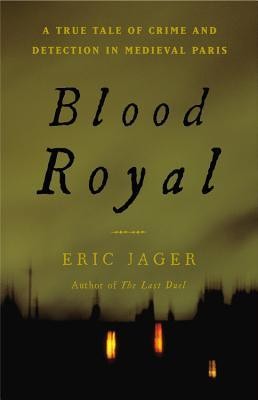A Detective in Medieval Paris

One of the most sensational crimes in French history, a bloody deed that would plunge the nation into civil war, took place in the Marais one dark night in 1407. On November 23, shortly after the 8 PM curfew bell, a band of masked men armed with swords and axes accosted the king’s brother, Louis of Orleans, in the narrow Rue Vieille du Temple, just north of where it crosses the Rue des Rosiers. The street, no wider than today, was perfect for an ambush. As neighbors watched in horror from their windows, Louis’s assailants knocked him from his mount and hacked him to death on the spot, then disappeared into the dark. Some of them fled down the Rue des Blancs Manteaux past the little church where Louis’s body would be carried later that night for a vigil.
Since Charles VI was frequently insane, and Louis had often ruled in his place, the crime paralyzed the government of France and sent panic through the city. Suspects abounded: Louis was widely hated by the people for his high taxes, by members of the royal family for ruling in the king’s place, and by many noblemen at court whose wives he had seduced. Louis was also rumored to be sleeping with the queen, whose palace he had left minutes before he met his killers, so the mad king himself may have had something to do with his brother’s murder.
Shortly after the killers left Louis’s butchered body lying on a pile of mud in the street, a breathless messenger arrived at an imposing stone mansion across town in the Rue Béthisy, east of the Louvre (then a much smaller fort) and south of the city’s huge central market, Les Halles. This was the home of Guillaume de Tignonville, Provost of Paris, the king’s chief law enforcement officer. Guillaume knew Louis well, and the two men were apparently good friends, so the murder was not only a national emergency but was also a devastating personal blow. Guillaume, with his lieutenant and officers, all armed and carrying torches, rushed at once to the scene of the crime in the rue Vieille du Temple to investigate.
By now Louis’s body had been removed from the muddy pavement to a nearby house, about where 42-43 Rue Vieille du Temple stands today. Here Guillaume examined the corpse, laid out on a table and covered with black cloth. One hand had been cut off, the other arm slashed to the bone, and the head mutilated by ax-wounds “so enormous,” says his report, that “the entire brain protruded.”
From the people at the scene, Guillaume gathered some preliminary information and also sent men to search a nearby house apparently used by the assassins as a hideout. He had all the city gates closed to keep the killers from escaping, and he posted soldiers in the streets. Then he set about solving the crime, working through much of the night and apparently with little sleep over the next several days.
A brilliant sleuth, Guillaume marshalled the scores of officers and clerics at his command to examine the crime scene, collect physical evidence, depose witnesses, and ransack the locked-down city for clues. He questioned shopkeepers to see if they recognized items found in the assassins’ hide-out, and he ordered innkeepers throughout the city to bring him lists of their guests, in case the murderers were among them. What’s more, he wrote it all down.
We would know very little about Guillaume’s investigation were it not for a thirty-foot parchment scroll containing his report and sprinkled with grisly details. The scroll, filled with small, neat script now faded from black to brown, is one of the earliest surviving accounts of a police inquiry. Not long after the murder it went missing, only to turn up centuries later and far from Paris at an old château in the south of France.
Guillaume’s report has been studied by many scholars since the first excerpts from the rediscovered scroll were printed in the 1750s. But even today it is not widely recognized that Guillaume — a skilled knight and veteran of several campaigns, as well as an experienced diplomat and trusted royal advisor — was also one of history’s first detectives. Long before Eugène François Vidocq (founder of the Sûreté) and Jack Whicher (a model for Sergeant Cuff in the Wilkie Collins novel The Moonstone), Guillaume anticipated modern investigative procedures.
The scroll was probably drawn up at Guillaume’s headquarters, the Châtelet, a gloomy old fortress on the Right Bank and fronting the river — where a column now marks the Place du Châtelet with its busy Métro station below (line 1). The Châtelet had a morgue, several prisons, and an evil reputation because of the torture regularly used there to extract confessions. Various methods were employed, including an early form of waterboarding combined with a sort of rack.
Paris was Europe’s largest city, a teeming metropolis of over 100,000 — a noisy, crowded, smelly place of endemic crime and brutal punishment — as embodied by the Montfaucon gibbet, then outside the city wall to the north, on low hill still visible in modern Paris near the Place du Colonel Fabien. The poet François Villon famously memorialized the Montfaucon gibbet in his “Ballade des Pendus,” where several hanged men alarmingly speak to passers-by. Guillaume himself was no stranger to the place, nor did he seem to shirk from seeing the results of his own verdicts. Less than a month before Louis’s murder, he had ridden to Montfaucon at the head of a somber procession to hang two clerics convicted of robbery and murder.
But Guillaume’s main job was crime-prevention — and investigation. In a pre-modern twilight of ignorance and superstition, such as the popular belief that a corpse would bleed again if the murderer were nearby, Guillaume led the inquiry into Louis’s murder with what one modern expert on medieval law calls “a remarkable legal and scientific rigor.” Lacking modern forensic tools and computerized records, he relied mainly on shoe-leather, intelligence, and a courageous pursuit of the truth.
The several dozen witnesses summoned by Guillaume to give statements included barbers, shopkeepers and housewives — ordinary citizens clearly alarmed to be caught up in great events. They were deposed separately at the Chatelet in six small rooms by two-man teams, one asking them questions while the other recorded their testimony, his goose quill scratching on parchment. Six centuries later, their excited, worried voices come alive again in the transcripts, rich with everyday details from a long-vanished era.
A few witnesses had glimpsed the actual murder by torchlight. Jacquette, a shoemaker’s wife, had been holding her baby at a window above the street when she saw the gang of masked men knock Louis off his mount and slice him up with their swords and axes. As he screamed for help, she screamed, too, and the killers paused in their murderous work to shout threats at her.
After a number of false leads and dead ends, as well as reluctant or misleading witnesses, Guillaume found the man who had rented the house to the assassins, and several vendors who had sold them goods or supplies. He began to suspect a far-flung conspiracy reaching into some very high places. At great personal risk, he turned the tables on the conspirators and set a cunning trap for them that finally revealed the astounding truth.
Guillaume’s long, detailed investigation report does not so much as hint that he or any of his officers used torture or forced confessions to solve the case, despite the crime’s magnitude and the urgency of the situation. Instead, the Provost diligently collected evidence, deposed witnesses, and deduced the truth from the information thus obtained. Although in many ways a man of his age, in his police work he seems to have been well ahead of his time.
Besides a knight and an early detective, Guillaume was also a literary man. A friend of the poets Eustache Deschamps and Christine de Pizan, Guillaume belonged to a courtly literary club and had written some love poetry. He had also translated an originally Arabic book of moral wisdom from Latin into French, a work later printed throughout Europe and earning him an afterlife of modest literary fame.
But Guillaume should also be remembered for another work, his investigation report, an ordinary office document about an extraordinary crime. And his sober, methodical inquiry into the shocking 1407 murder should assure this brave, incorruptible knight’s place in history as a pioneering detective.
Eric Jager teaches medieval literature at UCLA. His latest book, Blood Royal: A True Tale of Crime and Detection in Medieval Paris, was published this year by Little, Brown and Company.
Share to: Facebook Twitter LinkedIn Email
Leave a reply
Your email address will not be published. Required fields are marked *



